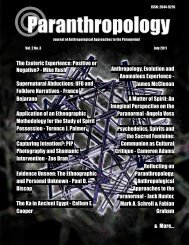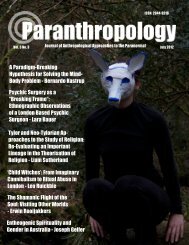Psi and Psychedelics - Paranthropology - Weebly
Psi and Psychedelics - Paranthropology - Weebly
Psi and Psychedelics - Paranthropology - Weebly
You also want an ePaper? Increase the reach of your titles
YUMPU automatically turns print PDFs into web optimized ePapers that Google loves.
PARANTHROPOLOGY: JOURNAL OF ANTHROPOLOGICAL APPROACHES TO THE PARANORMAL VOL. 2 NO. 2<br />
The Anthropological Evidence<br />
The folklore surrounding the pineal gains<br />
greater physical reality from certain<br />
specific divinatory practices among a<br />
large number of<br />
South America Indian tribes. These tribes<br />
all use a vine of the genus Banisteriopsis<br />
mixed with other plants, in order to<br />
induce visions specifically for a variety of<br />
psychic purposes. The Amazonian Indians<br />
call this vine ‘the Sacred Vine.’ There are<br />
hundreds of psychoactive plants in the<br />
Amazon basin, yet all the tribes scattered<br />
over this huge area use this vine. 4<br />
Early chemical investigations of<br />
Banisteriopsis indicated the presence of<br />
an alkaloid which was actually given the<br />
name 'telepathine' in 1905 by Zerda<br />
Barron 5 because of its supposed telepathic<br />
properties. This alkaloid was finally<br />
identified as harmine, which had been<br />
independently isolated from seeds of<br />
Syrian rue (Peganum harmala). Syrian<br />
rue is used in Morocco to counteract<br />
harmful psychic influences. The harmala<br />
alkaloids are extracted by shamans from<br />
Banisteriopsis caapi in Colombia under<br />
the name of Yage, in Ecuador <strong>and</strong> Peru by<br />
the name of Ayahuasca, in Brazil by the<br />
name of Caapi, by the Shuar people who<br />
call it Natema, <strong>and</strong> by the Cashinahua<br />
who call it Nixipae. Banisteriopsis is<br />
usually mixed with other plants such as<br />
Prestonia amazonica <strong>and</strong> Psychotria<br />
viridis (Cawa), which have<br />
hallucinogenic properties, the active<br />
ingredient being dimethyltryptamine<br />
(DMT). (It seems that tryptamines can be<br />
rather trippy!) This mix of vine <strong>and</strong> herbs<br />
is essential, since orally ingested DMT is<br />
inactivated in the gut <strong>and</strong> the harmala<br />
alkaloids from Banisteriopsis enable it to<br />
be assimilated into the blood stream <strong>and</strong><br />
hence produce its hallucinogenic effects. 6<br />
The anthropological evidence,<br />
however, points to Ayahuasca being more<br />
than merely hallucinogenic. The original<br />
name 'telepathine' was not inappropriate<br />
as the following anthropologist's reports<br />
suggest:<br />
Among the Jivaro, it is felt that part of the<br />
soul may leave the body, with the subject<br />
having the sensation of flying, returning<br />
when the effects of the drug wear off ...<br />
The Conibo-Shipibo Indians ... report that<br />
a common function of Ayahuasca taking<br />
by shamans is to permit the shaman's soul<br />
to leave his body in the form of a bird ...<br />
Among the Amahuaca 'a man's soul may<br />
leave his body when he drinks<br />
Ayahuasca'. 7<br />
These experiences are also reported by<br />
the Ziparo, the Tukano <strong>and</strong> the Siona, <strong>and</strong><br />
can be considered to be fairly typical<br />
reports of what are now called out-of-thebody<br />
experiences. (This use of a<br />
psychotropic plant for out-of-body<br />
experiences matches that of the witches'<br />
flying ointment.) But experience of outof-body<br />
effects does not necessarily mean<br />
that the vine is psi-conducive, although it<br />
is a good indication that psi may be close<br />
by.<br />
The Amahuaca report not only<br />
separation of the soul from the body, but<br />
that after the sorcerer has drunk<br />
Ayahuasca, his yoshi — a jaguar spirit —<br />
will appear to him <strong>and</strong> tell him everything<br />
he wants to know, including the<br />
whereabouts of the intended victim. The<br />
Conibo Indians believe that the taking of<br />
Ayahuasca permits them to see the<br />
supernatural aspect of nature, <strong>and</strong> the<br />
Jivaro shamans believe that they are<br />
25 PARANTHROPOLOGY: JOURNAL OF ANTHROPOLOGICAL APPROACHES TO THE PARANORMAL




